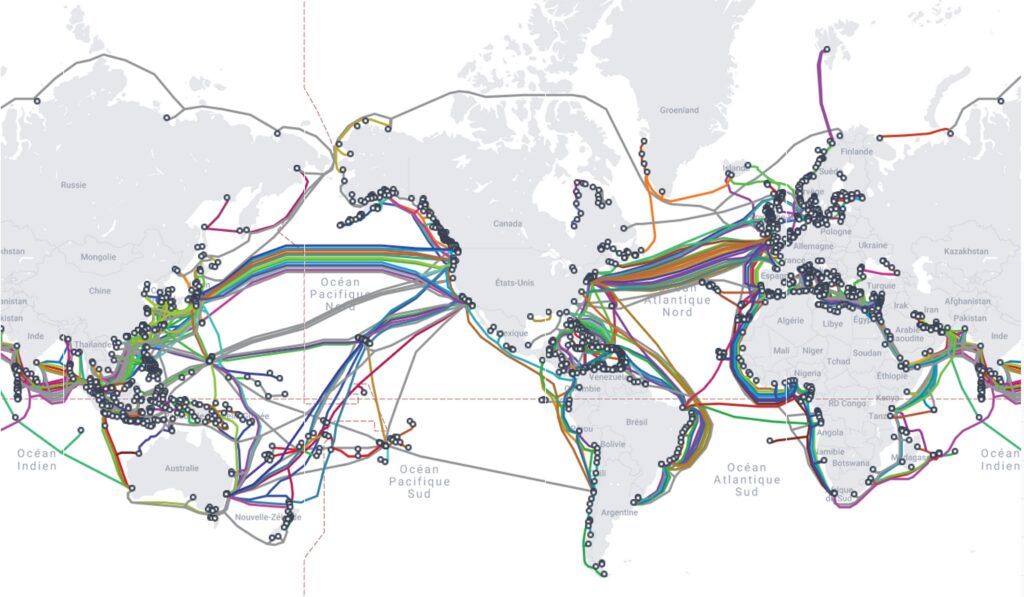Cyberspace is a term popularized by American science-fiction writer William Gibson in his novel Neuromancer (1984). Gibson presents cyberspace (also known as « the Matrix ») as « a consensual hallucination experienced daily in complete legality by tens of millions of operators, in every country, by kids who are taught mathematical concepts… A graphic representation of data extracted from the memories of all the computers in the human system ». This definition was then often used in the 1990s to designate the Internet.
Cyberspace: both the global interconnection of equipment and the space it generates
It’s a set of interconnected networks of computers – and more and more mobile objects (telephones, tablets and soon refrigerators, wristbands, sports shoes…) – human networks and data flows. -It’s a space of deterritorialized information and exchange.

Cyberspace is made up of four layers:
- The physical layer, made up of submarine and terrestrial cables, and even satellites in outer space. This is the Internet’s physical infrastructure, designed for maximum openness and circulation of information, with no built-in security.
- The logical layer: this layer transmits data between two points on the network, using the TCP/IP Internet protocol. This protocol is a common language that enables all the world’s computers to communicate with each other.
- routing (paths taken): choosing the route by which data packets travel between two networks
- naming (domain names): names identifying network elements or users
- addressing (IP addresses): transforming the series of numbers representing addresses into intelligible words for users
- The applications layer: these are user-friendly computer programs that enable users to use the Internet without knowing anything about computer programming;
- web, e-mail, social networks, search engines…
- stored on servers managed by private or public bodies
- The information and social interaction layer (cognitive or semantic): user information, discussions and exchanges in real time throughout the world, without built-in security.
Cyberspace and digital sovereignty
Digital transformation affects every aspect of society, and has given rise to a new space for communication and information sharing: cyberspace. Its characteristic feature is that it frees itself from traditional borders between states – be they territorial or political – and overturns the notion of space-time. Cyberspace has become a space of struggle and power relations. Digital platforms are based on technologies and an organizational logic founded on re-intermediation and data-ification, transforming users into agents of production and consumption.
Digital: steering the course
The independence of a state is built around four pillars: population, territory, power and political legitimacy. Let’s transpose these concepts to the digital space.
Population – the data on display reflects goods and people in the digital space. This data is captured by the tools we use. The quid pro quo for the services we enjoy without paying in cash is in digital form, in data.
Territory – we often hear it said that digital technology has abolished territory, that there are no longer any borders with the notions of cloud computing. Data is on earth, on a territory where laws apply.
Power – in the physical world, the notion of power refers to economic, military and cultural power (soft power). In the digital world, power is represented by the computing and storage capacities of infrastructures. It also includes the people who know how to design and operate digital tools.
Political legitimacy – States have been built around election and membership. In the digital world, membership is materialized by the acceptance of « cookies » and general conditions of use. These consent formalities can be likened to a form of voluntary submission.
Technology and platform capitalism
The emergence of multinational platforms organizing the interaction of a multiplicity of companies and consumers is giving unprecedented impetus to the construction of a new eco-system driven by a constant flow of information innovations. Shoshana Zuboff’s The Age of Surveillance Capitalism (1999) describes how global technology companies such as Google and Facebook have persuaded us to give up our privacy in the name of convenience; how the personal information (data) collected by these companies has been used by others not only to predict our behavior, but also to influence and modify it; and how this has had disastrous consequences for democracy and freedom. Shoshana Zuboff defines « surveillance capitalism » as a « new economic order » and « an expropriation of essential human rights that is best understood as a coup d’état from above ».
Different types of platform can coexist and delineate contrasting reconfigurations of the modern world: market-led platform capitalism in the USA, a panoptic control society in China, while ideally the European Union aims to convert information into a global commons, monitored by citizens.
Long before the emergence of the Internet, anything that could be translated into information would be – exchanges, events, objects – and data flows were used wherever possible for surveillance and control. The digital revolution turned into a rogue mutation marked by concentrations of wealth, knowledge and power unprecedented in human history. Google has admitted to scanning private correspondence on its Gmail network for personal information. Facebook’s business model has been based on capturing and accessing personal information. Big tech sells certainty to commercial customers who would like to know with certainty what we are doing. They want to know how much they can get from us in an exchange. It’s a movement based on predictive algorithms, mathematical calculations of human behavior and automatic emotion recognition techniques. These companies want to know how we’re going to behave, so they know how best to intervene in our behavior. The best way to make predictions desirable to their customers is to ensure that they come true. This is behavior modification. In 2012 and 2013, Facebook conducted large-scale contagion experiments to see if they could affect emotions and behaviors in the real world, without.
